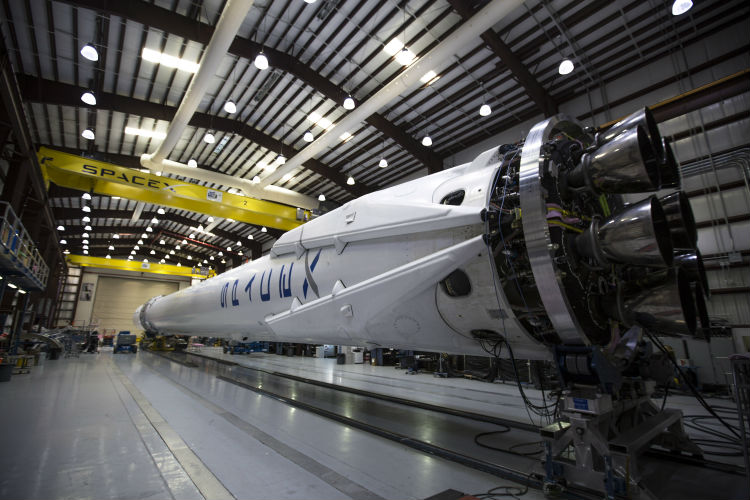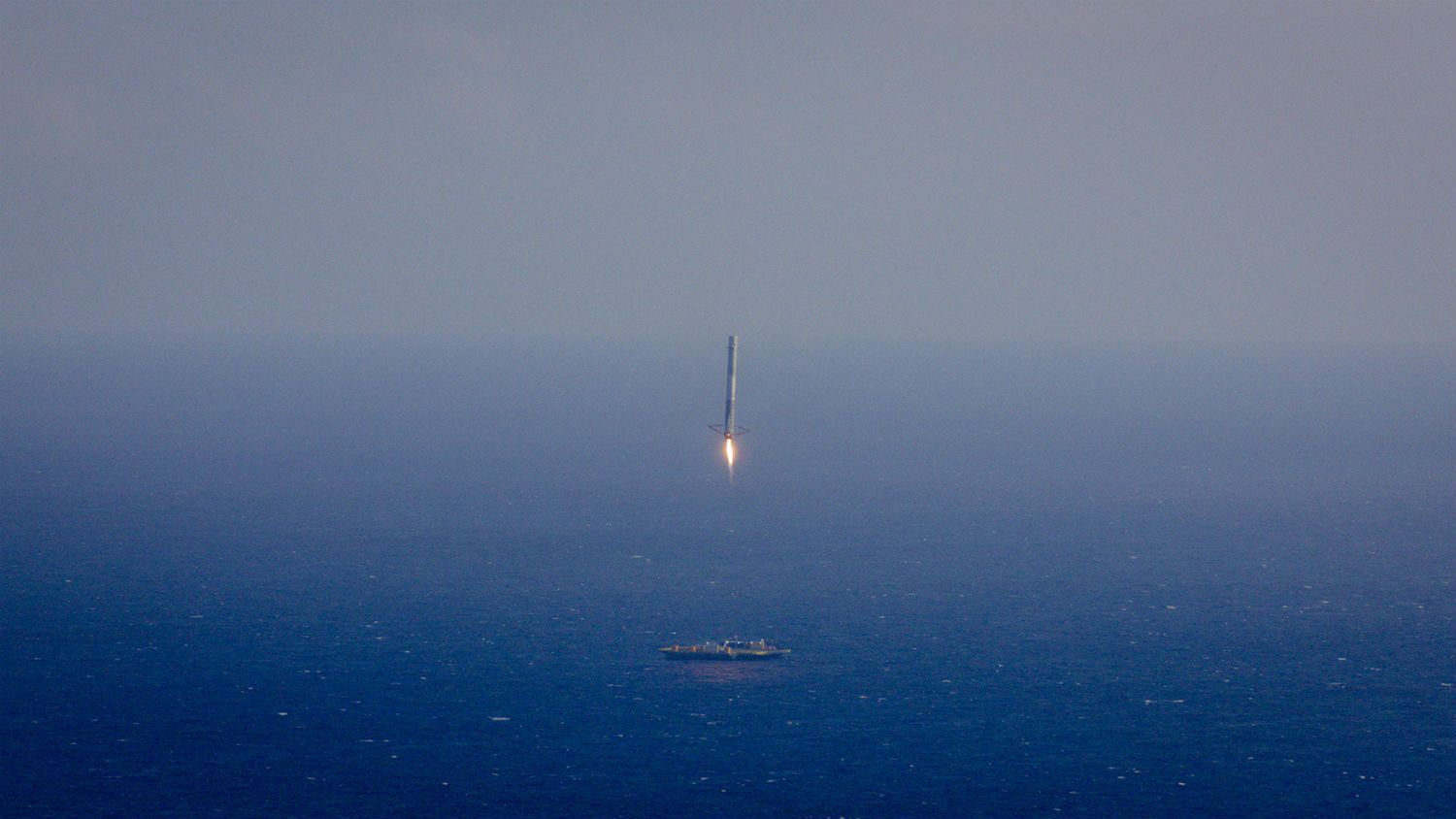In case you hadn't been following along, rocket technology is on the cusp of changing human civilization forever.
Over a decade ago, SpaceX started out with the goal of drastically reducing the cost of spaceflight. How? By reusing flown rocket boosters. How? Well, no parachutes—upon releasing its cargo into space, the rocket booster is piloted back into the atmosphere and down to the surface for a precise landing. How? With really good software and slight hardware improvements (ie. landing gear).
This is being done by software, not humans. Image: SpaceX.
SpaceX has been making the incremental improvements necessary to be able to recover and re-fly their rockets—and now they've finally done both.
The company attempted the first-ever landing of an orbital rocket booster back in 2015. Since then, they've stuck nine landings: eight different boosters returned to Earth, one lost in a pre-flight explosion, and one booster that's now flown to space and back twice.
An oft-used analogy to characterize the significance of this milestone is to imagine if commercial airline flights were one-offs; that every time you flew, the plane was scrapped afterwards. Since those planes can cost hundreds of millions of dollars to build, just one ticket would cost millions of dollars—and almost nobody would be able to afford it. Instead, we build planes capable of making thousands of individual flights, making air travel affordable to almost everyone in the world. SpaceX is attempting to replicate this cost-optimization in spaceflight—and so far, so good.
There is a certain inevitability about it all. As long as our civilization doesn't get smacked backwards by some huge disaster or come to some unforeseen end, we can make a few plausible predictions about the future: human beings will explore deep space; we will find signs of life on other worlds; and we will establish human colonies on the Moon and Mars.
These achievements in themselves aren't ifs and maybes. They're merely a function of incremental technological improvement met with time. The former has been going on continuously for centuries (and only seems to be accelerating), while the latter shows no signs of stopping at all. As long as we can guard our civilization from complete collapse, we have a bright future ahead.
Unfortunately, most people have a tough time making accurate predictions about the future. We're either overly optimistic or utterly pessimistic—we either don't see disruption coming at all (Kodak ignored the rise of digital cameras), or we're left perpetually wondering how much longer until we all have flying cars (don't worry, they're still coming!). Predicting the future in a complex world is a 21st-century sort of skillset, and most people suck at it.
So yes, SpaceX is probably going to accomplish all of the things that they've set out to accomplish. Success tends to beget more success. It may not happen on the sort of timescales that Elon Musk is touting, but make no mistake about it: SpaceX is going to change spaceflight forever. And most observers will either be cheering along or sitting dumbstruck on the sidelines wondering 'how'd they pull that off' in perpetuity.
 An already-flown rocket, ready for another go. Image: SpaceX.
An already-flown rocket, ready for another go. Image: SpaceX.
For another concrete example of the pace of innovation, look at the automotive industry. Toyota introduced the hybrid Prius two decade ago. But since then, fully electric vehicles have become vastly more practical, with nearly every major manufacturer now offering (or planning) a fully-electric vehicle.
We're approaching a tipping point where hybrid vehicles—once the most environmentally-friendly automobile option on the market—are beginning to look a little silly. Why waste all of that space and weight on strapping a giant oil-burning machine to the front of your car when you could instead install additional batteries and forego gasoline entirely?
The only reason the Prius still exists as a hybrid is because everyone is still accustomed to combustion engines—technology is moving along faster than the rate of consumer adoption. But that's only because most people don't see the future trend. As batteries continue to become cheaper and more efficient, the electric-car movement will accelerate.
Some analysts have predicted that, by 2030, the majority of cars on the road will be powered exclusively by electricity. Buying a gasoline-powered vehicle will become a rarity, and the infrastructure for fueling stations will begin to dismantle. At some future point, it will simply become more practical to purchase an all-electric vehicle.
Another example in the automotive industry is that of automation—by 2020, there will be ten million self-driving cars on the road. By 2030, a highly conservative estimate is that one-in-four cars will be self-driving (I'd guess that every car sold in the developed world will be). This trend is primarily a matter of convenience: why would I want to sit in the driver's seat and manually drive my car when I could otherwise spend my time doing something more interesting on my smartphone or tablet? The bottom line is that autonomous vehicles will give the gift of added time in the day to hundreds of millions of people who would be otherwise focused on their daily commute. For some people, that could add up to hundreds of hours per year.
Now, let's bring it back to the rockets. SpaceX sticking the landing of a twice-flown booster isn't necessarily some flashy new technology that will never see widespread adoption—it's 90% software. That means it could, with minor adjustments, be implemented in every rocket launch globally. Like the inevitability that we'll all soon be commuting in fully-electric and fully-autonomous vehicles, in the future, every rocket flown will have the ability to launch and land safely. The cost to do so is minuscule, and the pay-offs are potentially massive.
SpaceX rockets in flight... Image: SpaceX.
If things go according to plan, SpaceX will have their rockets flying as regularly and reliably as commercial airliners.
Barge landing delight. Image: SpaceX.
NASA is currently spending billions of dollars developing the SLS rocket—soon to become the largest rocket built since the Apollo-era Saturn V. A lower-estimate for the cost of launching the SLS is $500 million a pop. And while it's currently not planned to be reusable, doing so could drastically lower the price to the point where using it might actually become practical.
Hell, even without reusing a spent booster, bringing it back to the ground in-tact is in itself valuable. This would allow for post-flight inspection in order to ensure the vehicle is functioning optimally and that there's no sign of impending failure. And if reuse/refurbishment were deemed impractical, the vehicle could even be dismantled and recycled. It's a win-win option.
So, what does this all mean? The net effect of reusing rockets is that access to space will become cheaper and easier than ever before in human history. This means satellites become more affordable—think about GPS systems that are accurate to the centimeter, or global high-speed internet being beamed down to every location on Earth. And then of course there's the exploration aspect—rocket launches currently account for a significant fraction of the total budget of any given space mission, so reducing that cost substantially would free up more funds for the actual science.
With the success of the reused Falcon 9 booster, history is being made right now. But it isn't all flowers and rainbows, and there will be set backs. Spaceflight disasters are inevitable, and space is hard. But the general trend is upward and onward—to the Moon, Mars, and beyond.




